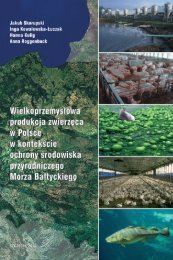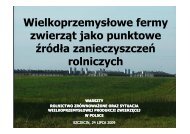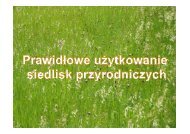best available technologies for manure treatment - Baltic Green Belt
best available technologies for manure treatment - Baltic Green Belt
best available technologies for manure treatment - Baltic Green Belt
You also want an ePaper? Increase the reach of your titles
YUMPU automatically turns print PDFs into web optimized ePapers that Google loves.
Best Available Technologies <strong>for</strong> <strong>manure</strong> <strong>treatment</strong> baltic sea 2020<br />
2: METHODOLOGIES AND ORGANISATION<br />
2: METHODOLOGIES AND ORGANISATION<br />
2.1: Methodology<br />
2.1.1: General approach<br />
The project, here under the data compilation and<br />
creation of a complete list of <strong>manure</strong> <strong>treatment</strong><br />
<strong>technologies</strong> from source to disposal of the livestock<br />
<strong>manure</strong>s, and a reduced list, i.e. the recommended<br />
<strong>technologies</strong> in relation to the objectives of this project,<br />
has been done via<br />
• Compiling and structuring already known<br />
knowledge and searches <strong>for</strong> newest scientific<br />
literature, relevant reports and document etc.<br />
– see list of references in Annex B.<br />
• Per<strong>for</strong>ming a survey among network partners in<br />
the project target area and in other relevant<br />
countries – the content of the survey was largely<br />
<strong>for</strong>mulated by the <strong>Baltic</strong> Sea 2020 secretariat,<br />
while the Project Leader organised the programming<br />
of an Internet based version of it.<br />
• Study visits to Holland and USA, especially to get<br />
on-hands impressions, to be acquainted with<br />
on-going and not yet published research, and <strong>for</strong><br />
reviewing current <strong>manure</strong> management technology<br />
practices.<br />
• The identified <strong>technologies</strong> are on basis of well<br />
documented effects (in some cases on basis of<br />
researchers personal in<strong>for</strong>mation or qualified<br />
estimates), concrete prices and other facts analysed/evaluated<br />
with respect to environmental<br />
effects (total/ammonia/nitrate N and P, other<br />
environmental effects), economy/profitability<br />
(income/savings – <strong>for</strong> instance from improved<br />
fertilising value of the livestock <strong>manure</strong>, investment<br />
price, running/operational costs, pre-requisites/enablers<br />
(herd size/scale of economy, <strong>available</strong><br />
land, distance to <strong>available</strong> land, price of<br />
energy, <strong>available</strong> subsidies, etc.)<br />
• Stakeholder consultations via a roundtable discussion<br />
in Stockholm on 29 September 2009.<br />
• Consultations with Researchers/experts, who<br />
represent the countries in the target area in the<br />
Technical Working Group connected to the<br />
European IPPC Bureau. Some of those, who<br />
could not participate in the Roundtable discussion,<br />
have been consulted at individual meetings<br />
about <strong>for</strong> instance the efficiency of the implementation<br />
of the IPPC Directive.<br />
• Data analysis to make a reduced list of most interesting<br />
<strong>technologies</strong>.<br />
• Formulation of recommendations <strong>for</strong> Best Available<br />
Technology <strong>for</strong> <strong>manure</strong> <strong>treatment</strong> to reduce<br />
leaching of N and P.<br />
• Policy recommendations, here under <strong>for</strong>mulation<br />
of final recommendations on basis of analyses and<br />
evaluations.<br />
2.1.2: Principle concerning leaching, and its<br />
connection to the field effect<br />
It is anticipated in this report that there is a correlation<br />
between leaching and field effect (also called<br />
bio / plant availability) <strong>for</strong> N, except in cases where<br />
the N is converted to free N – N2 or other airborne N.<br />
The field effect is in Denmark defined as the<br />
amount of N in mineral fertiliser that gives the same<br />
yield as 100 kg N in livestock <strong>manure</strong> in field trials.<br />
If the field effect is 60%, <strong>for</strong> instance, then we anticipate<br />
that 40% is lost to the environment, mainly<br />
via percolation to the soil layers, whereof a big part<br />
is further leached to the aquatic environment, while<br />
some is immobilised in the soils.<br />
This report will thus use the field effect as one of<br />
the evaluation parameters <strong>for</strong> the leaching reduction<br />
effect of livestock <strong>manure</strong> <strong>treatment</strong> <strong>technologies</strong>.<br />
2.1.3: Broad meaning of <strong>technologies</strong><br />
This report deals with livestock <strong>manure</strong> <strong>treatment</strong><br />
<strong>technologies</strong> <strong>for</strong> installations <strong>for</strong> the intensive rearing<br />
of pigs.<br />
The word “<strong>technologies</strong>” shall be understood<br />
in a broad sense, <strong>for</strong> instance according this definition:<br />
“Technologies is the application of scientific<br />
or other organized knowledge - including any tool,<br />
technique, product, process, method or system - to<br />
practical tasks”.<br />
The following few words are further creating the<br />
20








